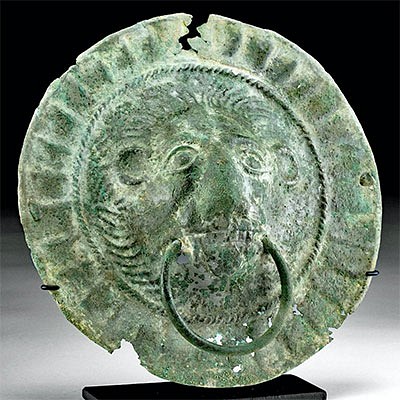19th C. Colonial Santo - St. Anthony / Christ Child
Lot 253b
About Seller
Artemis Fine Arts
686 S Taylor Ave, Ste 106
Louisville, CO 80027
United States
Selling antiquities, ancient and ethnographic art online since 1993, Artemis Gallery specializes in Classical Antiquities (Egyptian, Greek, Roman, Near Eastern), Asian, Pre-Columbian, African / Tribal / Oceanographic art. Our extensive inventory includes pottery, stone, metal, wood, glass and textil...Read more
Categories
Estimate:
$800 - $1,200
Absentee vs Live bid
Two ways to bid:
- Leave a max absentee bid and the platform will bid on your behalf up to your maximum bid during the live auction.
- Bid live during the auction and your bids will be submitted real-time to the auctioneer.
Bid Increments
| Price | Bid Increment |
|---|---|
| $0 | $25 |
| $300 | $50 |
| $1,000 | $100 |
| $2,000 | $250 |
| $5,000 | $500 |
| $10,000 | $1,000 |
| $20,000 | $2,500 |
| $50,000 | $5,000 |
| $100,000 | $10,000 |
| $200,000 | $20,000 |
About Auction
By Artemis Fine Arts
Oct 14, 2021
Set Reminder
2021-10-14 10:00:00
2021-10-14 10:00:00
America/New_York
Bidsquare
Bidsquare : CLEARANCE | Ancient & Ethnographic Art
https://www.bidsquare.com/auctions/artemis-gallery/clearance-ancient-ethnographic-art-7705
Kick off fall with our clearance sale featuring discounted pricing and many new items! Asian art, Classical antiquities from Egypt, Greece, Italy, and the Near East...plus Pre-Columbian, Tribal, Russian Icons & Enamelware, Spanish Colonial, Fine Art, Fossils, more! Starting prices have been reduced Artemis Fine Arts info@artemisgallery.com
Kick off fall with our clearance sale featuring discounted pricing and many new items! Asian art, Classical antiquities from Egypt, Greece, Italy, and the Near East...plus Pre-Columbian, Tribal, Russian Icons & Enamelware, Spanish Colonial, Fine Art, Fossils, more! Starting prices have been reduced Artemis Fine Arts info@artemisgallery.com
- Lot Description
**Originally Listed At $1000**
New World, Spanish Colonial, Mexico, ca. 19th century CE. A well-loved wooden santo with painted eyes depicting St. Anthony of Padua. In one hand, he holds a book with the Christ Child seated atop it; in the other he holds a lily stalk, representing his purity. He stands atop a tall, tiered wooden pedestal. He wears a tin halo and a worshipper has hung a thin chain around his neck. Size: 4.25" L x 4.625" W x 14.25" H (10.8 cm x 11.7 cm x 36.2 cm)
The saint's robes are pale green, with gold-painted details and a white-painted rope with three knots in the traditional Franciscan style representing poverty, chastity, and obedience; he also has a gold-painted tin halo. His face is sensitively rendered, with brown glass eyes. A silver crucifix on a silver chain has been placed around his neck by a worshipper.
St. Anthony was a Portuguese Franciscan priest and friar who died in Padua, Italy. Despite being born into a wealthy family, he was known for his intense devotion to the poor and sick, and holds the distinction of being canonized most quickly of all the saints. He is also known as the patron saint of lost things - objects, people, and souls. In art, he is often depicted with a book and the infant Jesus, based on a commonly told story of him reading a book and seeing the Christ Child's image in it.
Santos played an important role in bringing the Catholic Church to the New World with the Spanish colonists. These religious figures were hand-carved and often furnished with crowns, jewels, and other accessories, usually funded by religious devotees, and were used as icons to explain the major figures - Mary, Christ, and the saints - to new, indigenous converts. Likewise, they served as a connection to the Old World for Spanish colonists far from home. They became a folk art tradition in the Spanish New World, from modern day Guatemala to as far north as New Mexico and Colorado. Many of them were lovingly cared for over the years, with repairs and paint added as they aged, and played an active part for a long time in the religious life of their communities.
Provenance: private Francis & Lilly Robicsek Collection, Charlotte, North Carolina, USA, acquired second half of the 20th century
All items legal to buy/sell under U.S. Statute covering cultural patrimony Code 2600, CHAPTER 14, and are guaranteed to be as described or your money back.
A Certificate of Authenticity will accompany all winning bids.
PLEASE NOTE: Due to recent increases of shipments being seized by Australian & German customs (even for items with pre-UNESCO provenance), we will no longer ship most antiquities and ancient Chinese art to Australia & Germany. For categories of items that are acceptable to ship to Australia or Germany, please contact us directly or work with your local customs brokerage firm.
Display stands not described as included/custom in the item description are for photography purposes only and will not be included with the item upon shipping.
#120689Fine craquelure. Some losses to paint and overpainting as shown. Baby is missing the lower part of two arms and a leg, and the saint's other hand has losses to the fingers. Wax in areas used for attaching accessories.Condition
- Shipping Info
-
All shipping is handled in-house for your convenience. Your invoice from Artemis Gallery will include shipping calculation instructions. If in doubt, please inquire BEFORE bidding for estimated shipping costs for individual items.
-
- Buyer's Premium



 EUR
EUR CAD
CAD AUD
AUD GBP
GBP MXN
MXN HKD
HKD CNY
CNY MYR
MYR SEK
SEK SGD
SGD CHF
CHF THB
THB
















